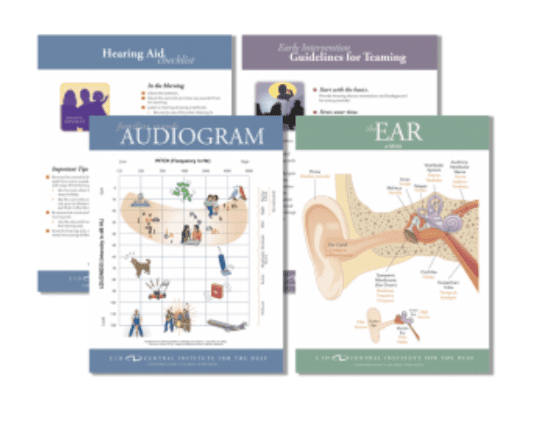When you hear hooves, think horses not zebras.
Hearing technology has improved immensely over the last decade, and language outcomes for children with hearing loss have improved as a consequence. Many children who receive early intervention services demonstrate standard scores on language tests within the average range for children with normal hearing by elementary school entry1. However, as increasing numbers of children with hearing loss enter mainstream education settings, new questions begin to arise. A common one seems to be: Do many children with hearing loss also have an attention deficit (such as ADHD)?
About a year ago, I heard from a parent of a child with hearing loss I used to work with. She was concerned because her child’s school was exploring the possibility of an attention deficit disorder diagnosis for her third-grade daughter, and this parent was, understandably, overwhelmed. Increasingly, I am hearing this story from other parents of children with hearing loss: even though a child met “typical language development” benchmarks in early elementary school, as that child gets older, he or she starts to have trouble focusing in the classroom.
As Karen Anderson’s previous post indicates, hearing loss itself may account for some of this behavior: listening through a device requires increased effort, which affects comprehension and leads to listening fatigue in the classroom. However, some (anecdotal) behaviors from children with hearing loss who have trouble with focus in the classroom may not appear to have a basis in listening. For example, children may rush through work, be easily distracted during class times, appear more interested in talking to friends than listening to the teacher, and seem unmotivated to participate in class work. These behaviors are often associated with the concept of executive function. Executive function includes skills such as planning, initiating, monitoring one’s own behavior, shifting attention and controlling impulses. Because attention deficits disorders (ADD/ADHD) are associated with problems with motivation, self-regulation, and impulsivity (in other words, executive function2, one could conclude that children who have hearing loss and display the above behaviors merit both diagnoses: ADD and hearing loss.
However, that conclusion merits a closer examination. To understand why, we must consider the basis and consequences of both diagnoses.
Hearing loss has a physiological basis and is diagnosed via behavioral and electrophysiological measures. Even for children who successfully use amplification, research indicates predictable deficits associated with a lack of exposure to sound (even for a short period of time, such as in the first year of life). Children who experience degrees of auditory deprivation tend to have difficulty with speech perception, production, vocabulary knowledge, and grammar3. Hearing loss is also broadly associated with delays in executive function. Difficulties with executive function for children with hearing loss likely have a basis in delayed language development: language performance and executive function correlate for groups with and without hearing loss2,4.
Attention deficit disorders have a neurological basis and are diagnosed using behavioral means – typically, via a comparison to Diagnostic and Statistical Manual of Mental Disorders (DSM-5) standards by a medical professional5. To obtain an attention deficit diagnosis, individuals younger than 17 must display at least 6 of 9 inattentive and/or hyperactive symptoms over a period of at least six months. However, the diagnostic criteria for attention deficit disorders are often rooted in language skills6,7. For example, the following items are included in the DSM criteria for inattention: “Often does not follow through on instructions…,” “Often has difficulty sustaining attention…e.g., has difficulty remaining focused during lectures,” “Often avoids or is reluctant to engage in tasks that require sustained mental effort, e.g., schoolwork”5. These items may be explained by a deficit in executive function skills alone, however, they may also be explained by hearing loss or subtle language deficit. For example, a child who does not hear directions well (or becomes fatigued) may not follow instructions well. Similarly, a child who has remaining subtle language difficulties may find it difficult to complete homework assignments.
Thus, one cannot automatically conclude that behaviors associated with attention deficits should be attributed to an ADD/ADHD diagnosis. One might ask: if executive function deficits are correlated with language skills for children with and without hearing loss2,4, is it likely that ADD/ADHD in a child with hearing loss is exacerbating a language difficulty caused by hearing loss? (In other words, could the executive function deficit actually be another cause of language difficulties we see in some children with hearing loss)? Evidence from children with specific language impairment provides us with some insight: although it is possible to have both language impairment and an ADD/ADHD diagnosis, these conditions have separate phenotypes and ADD/ADHD does not aggravate a language impairment7. If executive functioning deficits do not exacerbate language difficulties in a child with language impairment, it seems unlikely that they would exacerbate language difficulties in a child with hearing loss. In fact, ADD or ADHD might seem like an appropriate diagnosis for a child with hearing loss whose inattentive behaviors are actually a result of well-documented hearing-related language delays, particularly in combination with listening fatigue in the classroom.
Can hearing loss and ADD/ADHD co-occur? Yes. But, a child with ADD/ADHD should exhibit difficulties with inattentiveness and hyperactivity in both linguistic and nonlinguistic behaviors. The profession should consider, moving forward, that a diagnosis for children with hearing loss should certainly include characteristics of ADD/ADHD that are not listening/language-based.
Why does this matter? Primarily, because a misdiagnosis of ADD/ADHD may lead a family to explore counter-productive treatment options for a child with hearing loss. One of the most common treatments for ADD/ ADHD includes medication (particularly, stimulants)8. Although these medications prove highly effective for children who do have ADD/ADHD, the American Academy of Pediatrics also lists adverse effects that can include appetite loss, abdominal pain, headaches, sleep disturbance and decreased growth8. For a child who has ADD/ADHD, these possible adverse effects may be worth the risk to alleviate other inattentive and hyperactive symptoms. However, for hearing loss related behaviors, which have a different etiology, the risks may not be warranted.
Recognizing that inattentiveness in children with hearing loss is related to listening and language, rather than another diagnosis, may help us (parents and professionals) treat the appropriate cause of the problem. At this point, you might ask: so, if inattentiveness is the result of listening and language, rather than ADD/ADHD, how should we address it in the classroom? Unfortunately, the evidence base of intervention for children with hearing loss doesn’t provide a direct answer. For the child I referenced at the beginning of the post, we have tried some strategies that have yielded some short term success:
- First, we have engaged the child in direct instruction related to some of our deficit areas. These deficits have included: working on some language deficits not captured by global, norm-referenced language tests9: complex syntactic structures (e.g., relative clauses), nonliteral language, macrostructure of academic material (as is social studies and science), and working on some self-help adaptation skills to address issues with fatigue and listening effort, including note-taking and self-evaluation of comprehension.
- Second, we have discussed the child’s issues with her entire educational team. By helping other professionals (especially those who don’t spend lots of time thinking about hearing loss) recognize that deficits may not be related to ADD/ADHD or willful lack of effort, we’ve set up some in-classroom systems that are helpful for the child. For example, the child can subtly signal to her teacher (with an eraser on her desk) when she is lost or needs repetition. She also takes some “listening breaks” at appropriate times during the day (such as during silent reading).
Although we don’t currently have all of the answers related to the best way to address this situation in the classroom, identifying the root problem of inattentive behavior seems like a good first step.
When you hear hooves, think horses not zebras. When a child with a hearing loss has trouble attending in the classroom, ask first if it is a function of the hearing loss and related delays, rather than seeking another explanation to layer on top of an already complicated situation.
REFERENCES
- Geers, A., Tobey, E., Moog, J., & Brenner, C. (2008). Long-term outcomes of cochlear implantation in the preschool years: From elementary grades to high school.International Journal of Audiology, 47, S21-S30.
- For a review, see: Figueras, B., Edwards, L., & Langdon, D. (2008). Executive function and language in deaf children. Journal of Deaf Studies and Deaf Education, 13, 363 – 377.
- Houston, D. M., Beer, J., Bergeson, T. R., Chin, S. B., Pisoni, D. B., & Miyamoto, R. T. (2012). The ear is connected to the brain: Some new directions in the study of children with cochlear implants at Indiana University.Journal of the American Academy of Audiology, 23, 446-463.
- Kronenberger, W. G., Colson, B. G., Henning, S. C., & Pisoni, D. B. (2014). Executive functioning and speech-langauge skills following long-term use of cochlear implants. Journal of Deaf Studies and Deaf Education, 19, 457-470.
- American Psychiatric Association. (2013).Diagnostic and statistical manual of mental disorders (DSM-5®). American Psychiatric Pub.
- Redmond, S. M., & Ash, A. C. (2014). A cross-etiology comparison of the socio-emotional behavioral profiles associated with attention-deficit/hyperactivity disorder and specific language impairment.Clinical Linguistics & Phonetics, 28, 346-365.
- Redmond, S. M. (2016). Markers, models, and measurement error: Exploring the links between attention deficits and language impairments.Journal of Speech, Language, and Hearing Research, 59, 62-71.
- Dopheide, J. A. (2005). ASHP therapeutic position statement on the appropriate use of medications in the treatment of Attention-Deficit/Hyperactivity Disorder in pediatric patients. American Journal of Heath Systems – Pharmacology, 62, 1502-1509.
- Werfel, K. L., & Douglas, M. (2017). Are We Slipping Them Through the Cracks? The Insufficiency of Norm-Referenced Assessments for Identifying Language Weaknesses in Children With Hearing Loss.Perspectives of the ASHA Special Interest Groups, 2(9), 43-53.

Photo credit: Fort Worth Business Press; Glen Ellman
Emily Lund, PhD, CCC-SLP is an assistant professor in the Davies School of Communication Sciences and Disorders at Texas Christian University. Her research and clinical practice centers on language and literacy development of children with hearing loss who are developing listening and spoken language skills. Emily’s clinical and academic training took place in the National Center for Childhood Deafness and Family Communication at the Vanderbilt Bill Wilkerson Center. Currently, she is recruiting children with cochlear implants (ages 5 – 7) for a study on literacy development, funded by the NIDCD/NIH. If you have interest in participating, contact: hearinglosslab@tcu.edu or visit the CHLLD pages for more information: https://csd.tcu.edu/emily-lund-lab/ or https://www.facebook.com/TCUCHLLDLab/












